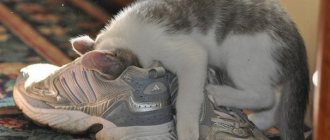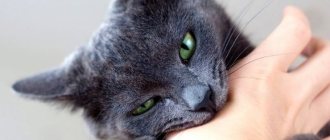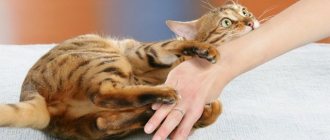Cats are cute pets that provide comfort in the home. However, sometimes they do things that are completely incomprehensible to the owner. For example, why does a cat bite? In fact, there are many sources of such behavior, and in this article we will try to understand them, and also try to help improve relations with a mustachioed friend.
Kitten
Norm or pathology
Sometimes some cats develop mental disorders, but this cannot be detected on their own. For this purpose, it is worth visiting a veterinarian and telling your concerns about changes in the animal’s behavior and the appearance of unmotivated aggression. Only a specialist will be able to determine whether this is related to pathology or is a character trait.
But most often bites are caused by other reasons. Cats are one of the most independent pets and this needs to be taken into account. And everyone's character is different. While some are very affectionate and love attention from their owner, others don’t like it.
Some animals, even living for a long time in a family, try to keep a distance from people and cannot stand a familiar attitude towards their person. These are already individual character traits and it will not be possible to change temperament.
Reasons for unexpected aggression
Cats can bite in different ways. There are two options for this behavior:
- The rarest one is when the pet gently bites its fingers, while the claws are removed and its actions are more pleasant than not. This is what they do most often when communicating with their offspring. When a cat behaves like this with its owner, it means it trusts him and loves him very much.
- More common is a sudden change in behavior. A second ago, the pet took the stroking absolutely calmly, showing no signs of aggression, but now it turned over and began to painfully bite and scratch the hand.
It is important to understand the reasons that motivate cats to bite and scratch their owner's hands. Among the most common are:
Aggression
Often a sign of problems with the pet's socialization. Breeders try to accustom a kitten to stroking in early childhood - up to 7 weeks of age. If this is not done, then in adulthood such an animal will shy away from affection from its owners and bite.
Pain
It is important to remember that cats, like people, are not always healthy; they have stomach, back, head, joint pain, and may have skin problems. Therefore, when showing affection, when something is not right with their health, they can bite. By this they are trying to tell the owner to leave them alone.
If behavior that is not typical appears, you should contact a veterinary clinic for examination, as this may be an indirect sign of illness.
Static electricity
Often, if the animal's fur is too dry and the air humidity is high, microdischarges may form when stroking. A person may not notice this, but it is extremely unpleasant for a pet, so he may bite.
Pet gender
This factor also needs to be taken into account. Many cats are more affectionate, but can be aggressive once they become mothers. Cats are often independent and do not like excessive affection, with the exception of castrated individuals; they begin to show more attention to the owner and demand the same from him.
Increased attention from a person
It must be remembered that these are independent animals that do not like being forced on them. The exception is Oriental cat breeds. Such pets are extremely sociable and loving. But they can also be in a bad mood when affection does not bring pleasure.
Dream
Some cats fall asleep during stroking and, if the rhythm or pressure changes, they may wake up and bite. This behavior is common among poorly socialized pets who always expect trickery from people. Or another situation - the animal is sleeping so soundly that stroking came as a surprise and frightened it. In this case, it is simply a defensive reaction against fear.
Dominant behavior
The cat thus tries to establish himself and show that he is the boss in the house. He tries to control the process of affection on the part of the owner.
Negative experiences in the past
Often people pet their pets before unpleasant procedures, such as nail trimming or bathing. But for them the model is fixed: if they stroked it, something unpleasant happened. And subsequent displays of affection on the part of the owner will provoke biting and scratching.
Early weaning
Cats teach their offspring that a person is a friend, he feeds, caresses and does not cause pain. If you take the kittens away from her too early, they won't recognize it and may perceive people negatively. Pets raised on the street also display a similar pattern of behavior. Cats do not know that their owners are trying to show their love and care in this way, but consider affection a threat to themselves.
Feeding kittens and pregnancy
During this period, some cats may experience a change in character, and in this way they try to protect their offspring and protect them.
Types of aggression in cats
Aggression often develops as a result of the appearance of a child in the family.
There are several types of aggression that can develop in a pet:
- Intraspecific - occurs when there is enmity between two animals. Two pets find themselves close to each other without having time to get to know each other at a distance. The result is a struggle for status and territory.
- Redirected - happens when some irritating action constantly occurs near the pet. So, an animal may see another cat outside the window, but not be able to drive it away from the territory - aggression is taken out on the owner.
- The answer to affection is that the cat does not want to be petted. Often a person does not notice warning signs - the pet twitches its tail, the body is tense, and there is no rumbling heard. If the owner continues to pet the irritated animal, the attack will not be long in coming.
- Reaction to fear - the pet is driven into a corner, he sees no other way out but to attack the offender. Visual signs of fear in a cat are a tail tucked under the body and a closed, compressed posture. Children often become aggressors - they frighten the animal with loud sounds and annoying actions.
- Protecting territory - a cat often bites and scratches when its personal boundaries are violated. She hisses, takes fighting stances, raising his fur.
- Pain is the main stimulus for a cat to show aggression. If some place hurts, it is better not to touch her. Often the owner is unaware of the pet's health problem. These could be diseases or injuries.
- Excitement in the game - often young cats or kittens painfully bite the owner’s legs and arms during the game. The reason lies in upbringing. If a kitten is orphaned early or separated from its mother, aggression develops.
Attention! Aggression in three- and eight-month-old kittens is often caused by changing teeth.
Cat behavior patterns
Experts have identified several behavioral patterns in cats when they can bite people:
A game
It's always aggression, but like studying or training. The objects are models (rubber ball, artificial mouse, rattle on a string, etc.). For kittens, this is training, learning to hunt, which is certainly accompanied by bites. Therefore, you should not play with your hands or feet with your pets, as they begin to be perceived as a “victim” that needs to be caught and neutralized. When playing with children, at first this behavior is amusing, but this pattern of play will become ingrained in him and in adulthood it will be difficult to wean him off this pattern.
You need to entertain your pets only with the help of special devices for cats.
Host - food
People are a source of food for their pets, so you shouldn’t tease them with food or treats, much less leave it all in a visible place. By biting and scratching, cats try to get their owners to give them another portion of goodies.
Licking the owner's hand - biting
Often people who keep a cat at home are surprised by this pattern: the pet was just purring and licking its fingers and suddenly bit. There may be several reasons for this behavior. For example, unrealized maternal instinct. When licking their offspring, cats may bite. Or it could be a sudden change in the animal's mood. Thus, the pet wants to say that he is tired of affection and needs to be left alone. To prevent such incidents, it is important to pay attention to the cat’s body language and notice changes in his mood. Thus, twitching of the tail and skin on the back, billowing fur indicate an imminent attack on the owner’s hand.
Resentment
For the most part, cats are not vindictive and do not hold grudges for long. But when the owner does not allow them to play with some object or does not allow them into a certain room, they can get angry and show their dissatisfaction with this by biting. With this behavior, you need to try to switch the pet’s attention to another thing, try to distract it with a game.
Secondary aggression
Cats are very addicting creatures and often after an interesting game with an artificial mouse, the owner, wanting to pet the pet, gets hit on the hand with a clawed paw. This happens because the animal has not calmed down and is still in the process of playing for a little while.
The recipe for this behavior is simple - let the cat calm down a little, and after time has passed, pet it.
Primary aggression
Often, in response to physical punishment, the pet begins to show hostility towards the owner. This is due to the fact that he adopts a human behavior model and enters into a kind of fight. It is important to remember that physical punishment is not the best way to raise cats and should not be used. You should scare him with a loud sound or sprinkle water to stop the attack. Sometimes primary aggression indicates an illness in the pet, so if all other reasons for this behavior are excluded, but if the cat continues to rush at people, you need to take him to a veterinarian for examination.
Aggression towards other animals (cats and dogs)
A striking example is the aggression of a mother cat when danger appears for her kittens. Such cat “negativity” can manifest itself both towards people and animals. Therefore, it is better not to disturb the mother cat and her offspring again. The place where she is with the kittens must be safe so that the cat is calm and that her babies are not in danger.
Enmity between two or more cats can also turn into aggression. They can fight for territory or simply “find out” which of them is stronger by meeting in open territory. Aggressive relationships arise between animals if one of them was recently brought into the house, and the other has been living in it for a long time, and even if the cats have been living in the same territory for a long time, then something can provoke their mutual aggression.
Sometimes a cat attacks and bites, reacting to a stimulus it sees and hears, to which it does not have access, so it takes out its feelings on those it can reach - household members or animals, even if they have done absolutely nothing to it. This is especially common in cats of oriental breeds. This phenomenon is called redirected aggression. At the same time, it may seem that the cat begins to fight for no reason at all. At the same time, the animal can remain so “reactive” for quite a long time.
Aggression over the division of territory can also manifest itself in “war” between species.
Cats often share a home with other pets, including those of the same species. And each of them may have their own reasons for “evicting” their opponent. In a cat, territorial type aggression can be directed towards various living objects - people, other animals, regardless of their species. But most often these are other cats. In this regard, it is dangerous to keep two sexually mature males in an apartment, as life will turn into a complete nightmare.
And even if the animals previously tolerated each other completely normally, but at some point one of them returned, for example, from the veterinarian, carrying a lot of unfamiliar (and even somewhat scary) odors, then the pet, staying at home at this time, unexpected aggression may arise. Since representatives of the feline family recognize members of their pride by their smell, if the absent animal comes back and smells different from everyone else, then it may be mistaken for a stranger. Much the same thing happens when one of the owners, who has been absent for a long time, returns home, then at first the cats may not accept him and behave aggressively.
Why does a cat bite just like that?
For the most part, cats never bite for no reason, but there are situations when people feel as if they are being attacked for no reason. However, this is not the case and there are several factors influencing this behavior, in addition to those described above. These include:
- Changing teeth. Animals, like humans, first grow baby teeth, which are subsequently replaced by permanent teeth. In cats, this period begins at 3-4 months of age. In this case, there may be pain and discomfort in the oral cavity, and they begin to actively bite the owner’s hands. It is important to prevent the pattern of such behavior from becoming established at this point. Otherwise, even an adult animal will continue to gnaw people’s fingers. You need to buy special rubber toys that your pet will scratch his teeth on.
- Sexual desire. During this period, many cats become aggressive. This is easy to notice: they leave marks on the territory of the apartment, scream heart-rendingly and ask to go outside. There are two options for solving the problem: castration and selection of a partner.
- Declaw removal. Currently, this inhumane operation is common in veterinary practice. If after it the pet begins to bite, this indicates either revenge, or that his teeth are the only weapon with which he can stand up for himself and this is what the cat uses.
- Lack of attention from people. If the pet is not played with and petted a lot, a bite is its way to interest the owner. You should devote at least 10 minutes a day to communicate with your pet, and the problem will disappear.
- Lack of care. If the tray is not cleaned or there is a lack of food, the cat tries to let the owner know that it is time to clean up his toilet or feed him.
What should the owner of an aggressive cat do?
So what should a cat owner do with an animal suffering from aggression caused by affection? Well, no one is saying it's a lost cause - it's really just a matter of learning how to tune into the animal's mood so you can predict when a petting session might turn into bloodshed. This might mean simply noting how long your cat will tolerate petting before she bites or scratches you, and then making sure you always stop before that moment comes.
Does your cat often scratch or bite you?
Found a violation? Report content
How to recognize readiness for an attack
Cats do not bite without warning; it is important to pay attention to the signs before attacking. These include:
- the animal's posture changes;
- the pet’s body tenses, which can be felt when touched;
- the purring suddenly stops;
- ears flatten;
- anger in the gaze, pupils dilate;
- the nature of the sounds produced becomes threatening, for example, rumbling, purring;
- the expression of the muzzle changes from peaceful to angry;
- the tail begins to twitch.
One or a combination of signs indicate that the pet is aggressive, that it has begun to get angry and that it will soon attack a person. You should not ignore them, but it is better to leave the cat alone for a while so that he calms down.
Classification of forms of aggression according to Moyer
Researcher Moyer classified forms of aggression in cats and dogs, and refuted the common belief that an animal attack is an element of feeding behavior caused by hunger. This was confirmed in the works of other scientists.
According to their research, the most common causes of inappropriate behavior are:
- the instinct of a predator seeking to suppress a rival whom the animal considers obviously weak and perceives as a victim;
- intraspecific aggression between males;
- fear;
- feeling of insecurity from danger;
- physical pain;
- maternal aggression, manifested in the desire to protect their offspring in any way;
- sexual, expressed in the struggle for a mating partner;
- a learned reaction that occurs when someone tries to “pay off” an aggressive animal or appease it with a treat;
- gaming;
- redirection of physiological pain or mental discomfort to surrounding objects, animals and people;
- conscious aggression, which is the result of negative interpersonal relationships between an animal and a person;
- the result of the manifestation of such feelings and character traits as conflict, the desire for self-affirmation and dominance, jealousy.
How to stop a cat from biting
There are several techniques that can be used to rid your pet of a bad habit and prevent it from developing. These include:
- Proper communication with guests. A kitten should not perceive people as aggressors, so it is worth accustoming it to them from a young age. But it is also important that those who come behave with respect for the pet: do not pick him up if he does not like it, do not throw him up (he may get scared) and do not bother him too much. If an animal has huddled in a corner in front of guests, there is no need to drag it out of its shelter to show off to your friends.
- Your pet should have toys with which he can have fun, but should not play with his hands.
- If a cat bites, you should make a sharp sound and he will let go, as it is unpleasant for him. For example, clap your hands or shout sharply.
- If episodes of aggression have become frequent, and all familiar causes of such behavior have been ruled out, it is worth visiting a veterinarian; the problem may be a pet illness.
- After the bite, show the cat that it is unpleasant. You can ignore requests for a treat or to continue playing.
- It is important for the owner to determine the approximate time during which the pet allows stroking and not to neglect this knowledge.
- In case of frequent bites, you can prepare a container with a spray bottle and spray it on the cat in case of aggression. He will get scared and run away. This will wean him from such behavior.
- Get vaccinated against rabies regularly. Your pet can become infected with this incurable disease and become dangerous to others. Therefore, you should not neglect regular visits to the veterinary clinic.
Second cat in the house
Here aggression can begin due to the presence of a stranger in the territory, because of fear, etc. One cat gets caught by another “under the hot paw”, begins to snap and hiss, which the aggressor perceives as a threat. The attack is repeated again. And so on in a circle.
How to behave
It is necessary to isolate the animals, you can make it so that they cannot attack each other, but at the same time “see each other”, for example, by fencing them off with a plexiglass wall. They can only be together if you are watching them and can stop the aggression in time: by spraying from a spray bottle and making a sharp sound. If the animals do not fight in front of you for 2–3 weeks, they can be taken out of isolation and allowed to communicate even when you are not around.
© Getty Images How to behave around cats: why they bite, what is the reason for bad behavior
What to do if kittens bite: parenting recommendations
Kittens, like children, need to be raised, only this is done differently. It is important to remember that the sooner you start this process, the more effective it will be.
It is more difficult to retrain an adult animal than a baby. If he bites hard, you need to stop playing and clearly, loudly say “No” and stop interacting with him, ignore him for a while. You can hiss at him after a bite. Another option is possible - to switch attention to something else, for example, a toy, but you cannot give a treat. Otherwise, he will take this as praise and will continue to behave aggressively towards people.
It is important for the owner to pay attention to the pet’s character and favorite places for petting. So, some cats like to be stroked on their bellies, while others categorically cannot stand it and allow themselves to be touched only on their backs.
In any case, it is necessary to find out the cause of aggressive behavior and eliminate the factors leading to it. If you can’t cope on your own, you can seek help from specialists.
1111
How to reduce the risk of aggression and raise an affectionate animal
An affectionate animal can only grow up in a caring and loving family. Never, under any circumstances, use physical punishment. Your hands should only be associated with affection.
Try to talk with your pet often and study its habits. If dissatisfaction appears, accompanied by warning signals, do not test his patience, but immediately stop the unpleasant actions.
If a cat grows up next to a child, make sure that the child knows how to handle it carefully. Stop sudden grabbing and squeezing.











